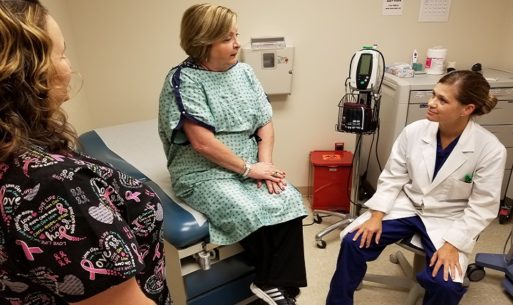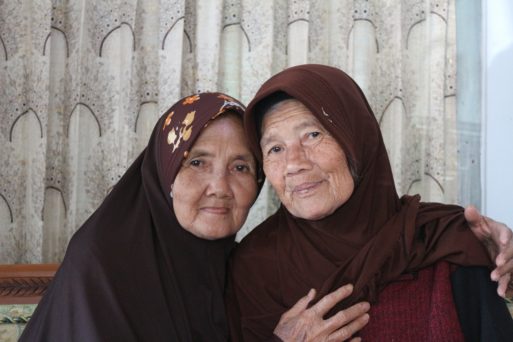Approaching the end of life is difficult enough without having to deal with language barriers and deep-set cultural norms that may affect the decision-making process. For Asians and Latinos, who are bound to tradition and may lack the necessary communication skills, making end-of-life choices presents unique challenges.

Credit: Jason Bortz, Naval Hospital Pensacola
Some Cultures Typically Don’t Talk About Dying
Many traditional Latino and Asian cultures consider speaking openly about death taboo. This may be especially true when a loved one is seriously ill.
“When we talk about the Chinese — that means people from Taiwan, Hong Kong and mainland China — we are all diverse,” says Marisa Ku in a Living My Culture video. But, she adds, “in general we don’t talk about death and dying, especially to our elders.”
Ku, a native of Taiwan who migrated to Vancouver, British Columbia, says end-of-life conversations can be considered a curse. “There’s a stigma … It’s a sense that the parents feel that the children want them to die as fast as they can,” she explains with an uncomfortable laugh. “So kids cannot talk to their parents about funeral planning.”
Chinese seniors residing at Mercy Housing, a low-income assisted-living community in San Francisco, recently told a grief counselor that even though they’ve religiously set up altars in honor of deceased ancestors, they have not spent time thinking about their own end-of-life choices. And less than 25 percent of those residents had had end-of-life conversations with their children. When asked why, one woman said they didn’t want to discuss death with their children because they were afraid it would upset them. Another woman said, “My children are actually even more fearful than us.”
Latinos, as well as Asians, are less likely than non-Latino whites to discuss their end-of-life choices or engage in advance care planning. Less than 10 percent of Latinos have announced or written down their preferences about the kind of end-of-life care they would want. As compared to non-Latino, white patients with advanced cancer, Latinos are less likely to sign do-not-resuscitate (DNR) orders, which is a form of advance care planning associated with better quality of life at the end of life.
Fear, Lack of Education and Poverty Compound the Problem
“Death is not something we really talked about until it happened,” admitted Luis Hernandez in reference to his mother’s death from cancer. She had been complaining about pain for a long time but was afraid of doctors and reluctant to see one. As is customary among Latino families, a male family member — in this case her son Luis — took responsibility for his mother’s care and respected his mother’s wishes about not seeing a doctor right away (also a traditional stance). Due to this mindset, they waited too long before seeing a doctor, who detected stage-four liver cancer. Luis’ mother died in the hospital shortly after emergency surgery.
During her medical crisis, events moved quickly. There was no time for her family to discuss hospice or alternatives to the aggressive medical interventions she ultimately received. “We’re not rich white people,” said her son. “What time does she have when she has to work a 9 to 6 o’clock job? And even on weekends, she’s working? Where do you find time to plan all of that out?”
In what can almost seem like a cultural contradiction, studies have indicated that once Latinos do admit a family member to the hospital for a grave illness, they will insist the hospital “do everything” to keep the terminal patient alive. Likewise, children of a Chinese parent will often advocate for aggressive, life-prolonging treatment out of a sense of filial duty.
Overcoming Cultural Barriers

Talking about end-of-life choices is taboo in some cultures.
The Asian and Latino tradition for home-remedy practices, lack of health insurance, and the threat of deportation for undocumented immigrants also contribute to these cultures’ reticence to discuss their end-of-life choices or engage in advance care planning. Analysts also cite the belief in fatalism and destiny held by some.
The old practices, however, show signs of evolving through experience and initiatives. After Taiwan native Marisa Ku volunteered at a hospice in Vancouver, she returned to school and is now a spiritual care provider. She says she has come to believe in “the generation of my age. We learn something different.”
Ku has become one of the increasing numbers of trained medical professionals and social workers who are making a critical difference in reaching out to ethnic patients and their families and helping them prepare for the end of life. These include professional translators who have a better handle on the patient’s native language than “ad-hoc interpreters” or medical staff who, though they may speak the language, may not know how to translate medical terminology. In addition, support workers are becoming better listeners through educational outreach training in “cultural humility.” This helps professionals let go of “being the expert” and become a “student” of the patient, which leads to a better understanding of the values and beliefs of the patient’s culture.
The Hospice of Santa Cruz County has also increased Latino participation in this end-of-life option by making home hospice care available in that community. Twenty years ago, Latinos made up only three percent of all hospice patients in Santa Cruz. Today, the number of Latinos in hospice has increased to 8 percent.
And On Lok Senior Health Services, created in 1971 in San Francisco’s Chinatown by a group of Chinese elders who wanted an alternative to nursing homes, now serves 1,500 frail elders. The majority are low-income Chinese and Latinos living in three Bay Area counties. At the end of their lives, On Lok provides them with comfort care similar to hospice. The program has been replicated in 30 states.

 Cultural Values May Inhibit End-of-Life Choices
Cultural Values May Inhibit End-of-Life Choices


 “Help Me, Helen”
“Help Me, Helen”
 Recovering Cremation Remains After the Los Angeles Fires
Recovering Cremation Remains After the Los Angeles Fires
 “As Tears Go By” by Marianne Faithfull
“As Tears Go By” by Marianne Faithfull














